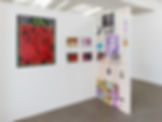
M.a.N.
Power of Print - The Work and Life of Bea Feitler, 2019; Kolnischer Kunstverein, Cologne
New Picture - The Work of Bea Feitler, 2018; UKS, Oslo
New Picture - The Work of Bea Feitler, 2017; Between Bridges, Berlin




































Power of print is a comprehensive survey of the revolutionary work, and life, of the late Brazilian art director and designer Bea Feitler (1938–1982).
The exhibition features original magazines, books, video documentation and reproductions from Feitler’s meteoric career, spanning from the late 1950s until her death, and personal photos and artifacts that document her life and circle of friends, collaborators and peers. Best known for her work in Harper’s Bazaar, Ms., Rolling Stone and the modern Vanity Fair, Feitler left an indelible mark upon the face of American graphic design by offering a new approach to the magazine experience.
Feitler’s expressive freedom, evidenced by shifting standards to a female gaze, allowed her to renegotiate the commercial representation of women and to use the magazine as a mass vehicle to address social issues through her vibrant aesthetic.
Power of Print threads some of her work’s recurrent themes – the human silhouette, centerfold as compositional device, collaging, innovative use of typography, solarisation and duotone, through which she reimagined the relationship between body, text and graphic design in both layout and sensorial terms. “A magazine should flow. It should have rhythm. You can’t look at one page alone – you have to visualize what comes before and after.”
Bea Feitler was born in Rio de Janeiro, after her Jewish parents fled Nazi Germany. She moved to
New York to study at Parsons School of Design and briefly returned to Brazil in 1959 where she designed posters, covers and spreads for books and for the progressive literary magazine Senhor.
In 1961 Feitler moved back to New York and shortly thereafter, at the age of 25, became the co-art director of Harper’s Bazaar with Ruth Ansel following the legacy of their mentors at the magazine Alexey Brodovitch and Marvin Israel. During their 10 years at the magazine, they shaped the emergence of a new feminist popular editorial language. Attuned to the political and cultural changes of the 1960s, they created some of the most iconic editorials of the decade.
Feitler and Ansel were ahead of their time: in 1965, with Richard Avedon, they used the first black model in a shoot for a major magazine, and in the same year, also with Avedon, they won the ADC medal for the April ‘space helmet’ Harper’s Bazaar cover. At the magazine, Feitler forged tight relations with photographers that lasted throughout her career; Avedon, Bill King and Diane Arbus, among others, were in her tight circle of friends. Her role as a main connector of the scene is portrayed in Power of Print through a collection of original artwork, personal photographs, postcards and letters from collaborators and friends, also including Andy Warhol, Annie Leibovitz, Jacques-Henri Lartigue, Ray Johnson, Tomi Ungerer, Candy Darling and Gloria Steinem. Her natural collaborative approach elevated the commercial editorial to an art form.
In 1972 Feitler joined Gloria Steinem to launch the feminist Ms. magazine. Here she created an experimental look using day-glo inks and mixtures of photography, illustration and typography compositions, activating the content of the magazine in both an accessible and critical way. Controversial messages were made more powerful through her masterful design, while feminist topics could enter into the mainstream. At Ms. Feitler had full control of visual content and a freedom that fueled her career. Today, the magazine is still pertinent and ahead of the curve and a hallmark of Feitler’s powerful, influential and unmistakable aesthetic.
Between 1974 and 1980 Feitler designed seminal books, such as The Beatles, Henri-Jacques Lartigue’s The Diary of a Century, Helmut Newton’s White Women, Vogue: Book of Fashion Photography. Reflecting her belief that the modern book should be 50-50 in terms of visuals and words, she negotiated to receive cover credit and royalty along the authors and/or photographers of the books she designed. She also art directed ad campaigns for Calvin Klein, Halston, Max Factor, Diane Von Furstenberg etc., record covers, as for the iconic Rolling Stone album Black and Blue, and posters and costumes for the legendary Alvin Ailey dance company.
In 1975, thanks to the insistence of Annie Leibovitz, Feitler started working for Rolling Stone, beginning her six-year association with the magazine which would lead her to redesigning its format twice. Feitler’s final project was the design of the premiere issue and overall concept of the revived Vanity Fair.
This exhibition has been made possible with the generous help of Bruno Feitler. An exhibition of Bea Feitler was also presented at Between Bridges in Berlin and UKS in Oslo, both in 2017, co-curated by Marte Eknæs and Nicolau Vergueiro. We would like to thank Between Bridges for their generous loans and Eugen Ivan Bergmann for his exhibition design contribution. Furthermore, we thank The Andy Warhol Museum, Pittsburgh for their loan and The New School Archives & Special Collections, New York, as well as the Alvin Ailey American Dance Theater, New York for providing additional material.